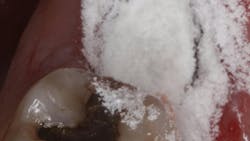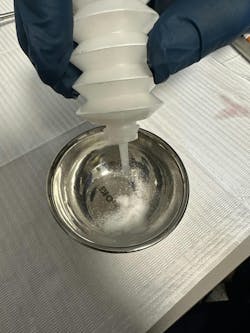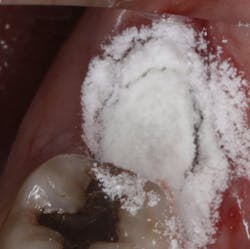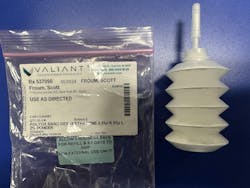Dry socket, also known as alveolar osteitis, is a painful condition that can occur after a tooth extraction when the blood clot that forms in the socket fails to form or is lost.1 This exposes the bone and nerves, which can cause pain and delay healing. Dry sockets can typically last seven to 10 days. Dry socket lesions occur in approximately 1%–5% of all extractions and in up to 38% of mandibular third molar extractions.2
What are the symptoms of dry socket?3
- Severe, persistent, throbbing pain within one to five days of the extraction
- Pain that may extend to your ear or eye on the same side of the face
- Bad breath
- A slight fever
- An unpleasant taste in the mouth
What are the risk factors of dry socket?4
- Complicated tooth extractions
- Smoking
- Use of oral contraceptives and/or high estrogen levels
- Poor oral hygiene
- Smoking or vaping
- Tooth or gum infection
- Previous dry sockets
Treatments for dry sockets include:
- Debridement of socket and placement of platelet-rich fibrin (PRF)5
- Pain relievers, such as ibuprofen or acetaminophen
- Flushing the socket with a medicated mouthwash or saline
- Filling the socket with a medicated dressing (oil of cloves)
- Placing drops of medicament with benzocaine or oil of cloves directly into the socket
What is the Polyox bandage?
The Polyox bandage is a mixture of Polyox WSR-301 and Methocel E4M, which creates an anhydrous powder that can be lightly dusted or puffed onto a wound (figure 1). Polyox is a water-soluble polymer that possesses a unique set of properties, such as quick hydration and adherence to mucosal tissue.6 As this powder hydrates and adheres to a wound (such as an extraction socket), it forms a protective barrier. This “bandage” or dressing is resistant to friction, which protects the wound.
How does the Polyox bandage lower the occurrence of dry socket?
There are many applications of the Polyox bandage for oral wound care, especially those that suppurate and/or bleed. This dressing is especially effective at covering an extraction socket and stabilizing the clot, lowering the incidence of dry socket (figure 2). Compounding pharmacies such as Valiant Compounding make this powder that will turn into the bandage. In addition, pharmaceutical ingredients such as antimicrobials and anesthetics can be added to the powder, further enhancing the bandage’s ability to lower dry socket occurrence.7 Mucosal tissue heals very quickly, so many times, just providing the protective covering will reduce pain and facilitate healing.
How is the Polyox bandage used?
Most compounders dispense the bandage in a squeezable bottle that looks like an accordion (figure 3). This device allows for a slight puff to be applied to the wound or lesion. For optimal results, the dentist would puff the bandage on, spritz with a sterile saline or blood/iPRF (injectable platelet-rich fibrin) for irrigation, and then reapply the bandage. Dentists interested in using this bandage will need to contact a compounding pharmacy, such as Valiant Compounding, as there are no commercially available bandages.
Editor’s note: This article originally appeared in Perio-Implant Advisory, a chairside resource for dentists and hygienists that focuses on periodontal- and implant-related issues. Read more articles and subscribe to the newsletter.
References
- Mamoun J. Dry socket etiology, diagnosis, and clinical treatment techniques. J Korean Assoc Oral Maxillofac Surg. 2018;44(2):52-58. doi:10.5125/jkaoms.2018.44.2.52
- Blum IR. Contemporary views on dry socket (alveolar osteitis): a clinical appraisal of standardization, aetiopathogenesis and management: a critical review. Int J Oral Maxillofac Surg.2002;31(3):309-317. doi:10.1054/ijom.2002.0263
- Bowe DC, Rogers S, Stassen LFA. The management of dry socket/alveolar osteitis. J Ir Dent Assoc. 2011;57(6):305-310.
- Younis MHA, Hantash ROA. Dry socket: frequency, clinical picture, and risk factors in a Palestinian dental teaching center. Open Dent J.2011;5:7-12. doi:10.2174/1874210601105010007
- Laforgia A, Inchingolo AD, Riccaldo L, et al. The use of platelet-rich fibrin (PRF) in the management of dry socket: a systematic review. Int J Mol Sci. 2024;25(18):10069. doi:10.3390/ijms251810069
- Polyox. IFF Nutrition & Biosciences. https://www.pharma.dupont.com/pharmaceutical-brands/polyox.html
- Fields SW. Compounding dental applications. Pharmacy Times. February 1, 2007. https://www.pharmacytimes.com/view/2007-02-6310
About the Author

Scott Froum, DDS
Editorial Director
Scott Froum, DDS, a graduate of the State University of New York, Stony Brook School of Dental Medicine, is a periodontist in private practice at 1110 2nd Avenue, Suite 305, New York City, New York. He is the editorial director of Perio-Implant Advisory and serves on the editorial advisory board of Dental Economics. Dr. Froum, a diplomate of both the American Academy of Periodontology and the American Academy of Osseointegration, is a volunteer professor in the postgraduate periodontal program at SUNY Stony Brook School of Dental Medicine. He is a PhD candidate in the field of functional and integrative nutrition. Contact him through his website at drscottfroum.com or (212) 751-8530.



